CyberPower's X6-9300 and MSI's GT680R: Fighting for Your Mobile Gaming Dollar
by Jarred Walton on May 13, 2011 10:59 PM EST- Posted in
- Laptops
- Intel
- MSI
- Clevo
- Sandy Bridge
- CyberPowerPC
- NVIDIA
Application Performance, Now with PCMark 7
We’ll start with our usual look at application performance, but we’re making a new addition to the benchmarks. Out goes PCMark05 results (we might still put them in Mobile Bench, but they won’t be in the articles) and in comes PCMark 7 (the seven is for Windows 7, incidentally; though the test runs on Vista as well, results may not be optimal and I’m not sure if you can run the full PCMark suite). Officially launched on May 12, PCMark 7 updates the benchmark suite with a revised set of applications and tests. This goes along nicely with the newly christened 3DMark 11, which we will get to in a minute.
We’re going to break with our mobile testing tradition and run the full suite of PCMark 7 benchmarks. They consist of the following areas: PCMark, Lightweight, Productivity, Creativity, Entertainment, Computation, and Storage. Each individual score represents a composite score for several other tests, and we’ll discuss some of the results in those tests where appropriate. Many have asked for additional application tests, and the various PCMark 7 benchmarks do a good job of running a variety of workloads. If you want to know the specifics of each test, you can consult the PCMark 7 Whitepaper.
With that introduction out of the way, here’s how the P151HM and GT680R stack up to the competition. We’ve used green for the two notebooks we’re focusing on in this review, gold for the Dell XPS 15 L502x, and black for the Clevo P150HM (sporting an i7-2720QM and an HD 6970M). The ASUS G73SW is also highlighted in a lighter blue, though most of the tests will have it running neck and neck with these two notebooks. As with any new benchmark, we don’t have a full set of results for all the older laptops and notebooks in PCMark 7, but we did run it on several other notebooks to provide some reference points. We’ll start there before moving to the rest of our application tests.
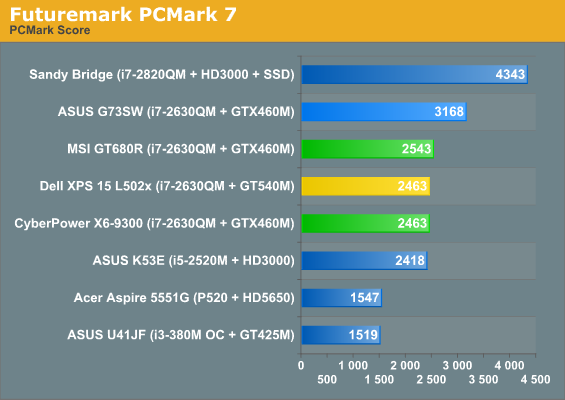
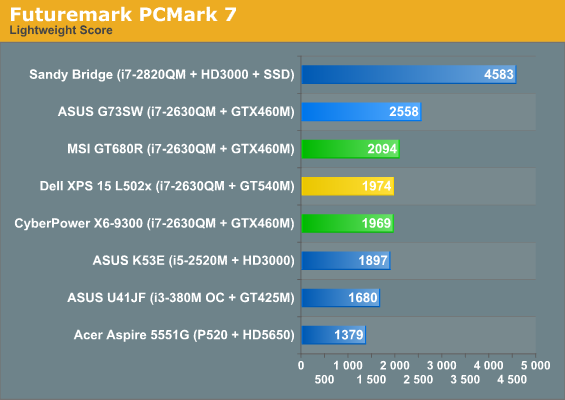
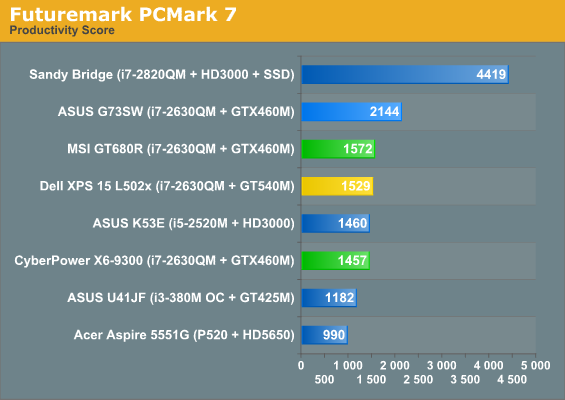
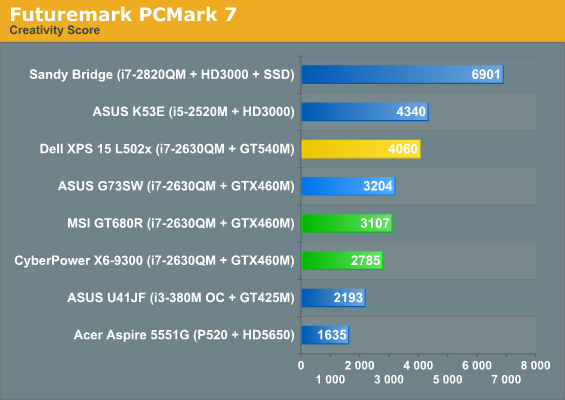
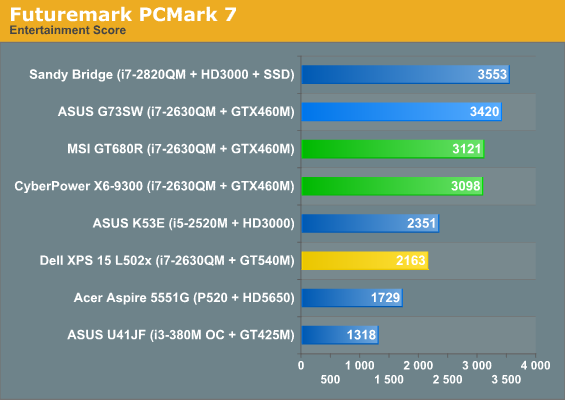
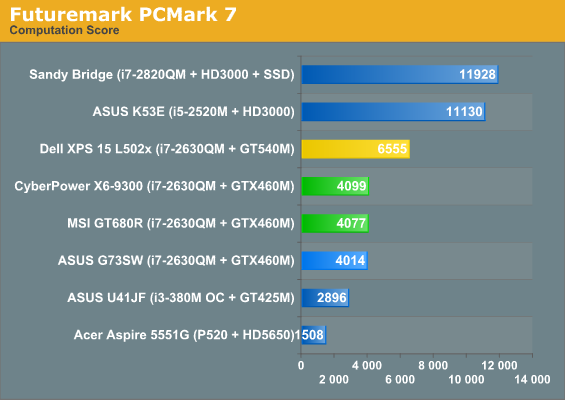
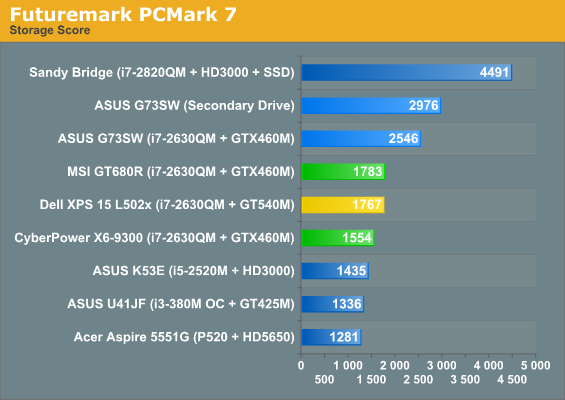
When we first ran PCMark 7, we noticed some oddities: the ASUS G73SW ended up beating the similarly equipped Clevo P151HM, Dell XPS 15 L502x, and MSI GT680R systems by 25%, which is well outside the margin of error we would expect. Looking at the individual test results, we quickly discovered the culprit: the storage subsystem results were around twice as fast on the ASUS compared to the other three laptops. The Dell has a 750GB 7200RPM Western Digital Scorpio Black, whereas the ASUS, Clevo, and MSI notebooks all use the venerable 500GB Seagate Momentus 7200.4; if those three all have the same HDD—heck, the MSI has two of them in RAID 0!—then why are the scores so different?
I decided to pull out the heavy guns on this one and make sure we were playing on a level field; that’s right: I defragged. Actually, I always do that before running benchmarks, but since I had just installed PCMark 7 I thought it was worth a shot. I reran PCMark 7 a couple times to see if some sort of optimization on subsequent runs was coming into play (e.g. SuperFetch). Nope; in fact, the first run on each laptop was usually the highest result out of five runs. After all the testing, I’m still not exactly sure what’s going on. I thought at first that since ASUS has two hard drives, so that might be part of it; however, PCMark 7 let’s you run the storage test on the secondary drive, and I did that as well (and generated an even higher result on the Storage test). A quick look at the ASUS K53E scores shows the same approximate doubling of HDD bandwidth in the various storage subtests, so I have to conclude that ASUS has a BIOS, firmware, or driver optimization that’s giving them a sizeable lead in the PCMark 7 results. Of course, that lead only holds up as long as you’re not looking at the performance of the Sandy Bridge i7-2820QM with an SSD.
In both PCMark 7 and PCMark Vantage (see below), the presence of an SSD definitely makes its presence known. Part of that is because SSDs really do make a system snappier in a lot of ways; the other part of the story is that storage related subtests are in every one of the PCMark 7 suites, with the exception of the Computation benchmark. There’s an interesting element to that test as well, though, in that it has two video transcoding tests, and both appear to use Intel’s Quick Sync when it’s available. The result is that the dual-core and quad-core Sandy Bridge laptops with no discrete graphics come out looking like a champ in that discipline—and they really are fast on video transcoding with the right application. We could force the Dell laptop to run only on the IGP, but interestingly it appears that Quick Sync is only partially used with Optimus. Anyway, don’t get too caught up in the charts, because the large differences in the storage related tests really skew the results.










44 Comments
View All Comments
strikeback03 - Tuesday, May 31, 2011 - link
One of the grad students I work with just bought an XPS 17 with the 3GB 555M for doing CUDA work, it has the 144 shader/DDR3 version of the 555M. Also, there don't seem to yet be proper drivers for using CUDA 4.0 with OptimusBolas - Saturday, May 14, 2011 - link
I'm waiting for a high end gaming notebook with a sandy bridge core i7 quad core cpu, dual high end gpu's, and a 120 Hz IPS screen. Is that so much to ask?tmacfan4321 - Saturday, May 14, 2011 - link
Is the Alienware M18x not good enough for you?BTW, 120Hz IPS displays are rare in monitor form. You're dreaming if you think that laptop manufacturers are going to be able to pull that one off.
Bolas - Saturday, May 14, 2011 - link
and of course, a backlit keyboard.Gnarr - Saturday, May 14, 2011 - link
holy jeebus MSI GT680R is one ugly computer... :SAnd on that note, I really like the simplistic and clean "no design" of the Cyberpower's case. If they had only skipped the glossy besel and had a backlit keyboard and maybe a little bit bigger touchpad, it would have been a really nice computer.
tmacfan4321 - Saturday, May 14, 2011 - link
If I owned an HM150, I'd probably take out the LCD and sand down the bezel. It would make the laptop a lot more aesthetically pleasing.jefeweiss - Saturday, May 14, 2011 - link
Looks like there's a missing paragraph under the photo gallery on the first pagejefeweiss - Saturday, May 14, 2011 - link
Oops, sorry it's on the Doing the time warp page....kevith - Saturday, May 14, 2011 - link
Why is it, that RAID 0 constantly is referred to in reviews like this, when every article or test I have ever read - your own here at Anandtech inclusive -ends up stating, that it has only theoretical effect, if any.tmacfan4321 - Saturday, May 14, 2011 - link
The Lenovo W520 hits on about all of those features that the author wants in a laptop with the exception of the price and sound quality. I ordered a heavily discounted W520 for $1500. The specs were as follows: i7-2720QM, NVIDIA Quadro 2000M with Optimus (GTX 460M with 128-bit bus), matte FHD screen with 95% color gamut (same panel as the RGB-LED Dell LCD), 4GB of RAM, 500GB 7200RPM HDD.The backlit keyboard isn't there, but there is the ThinkLight on the top of the display. The GPU is slightly slower than the GTX 460M because of its 128-bit bus and its Quadro BIOS. The battery life is awesome, due to Optimus. The build quality is stellar because it's a Thinkpad.
Normally that config will run you around $2000. That's the only problem.